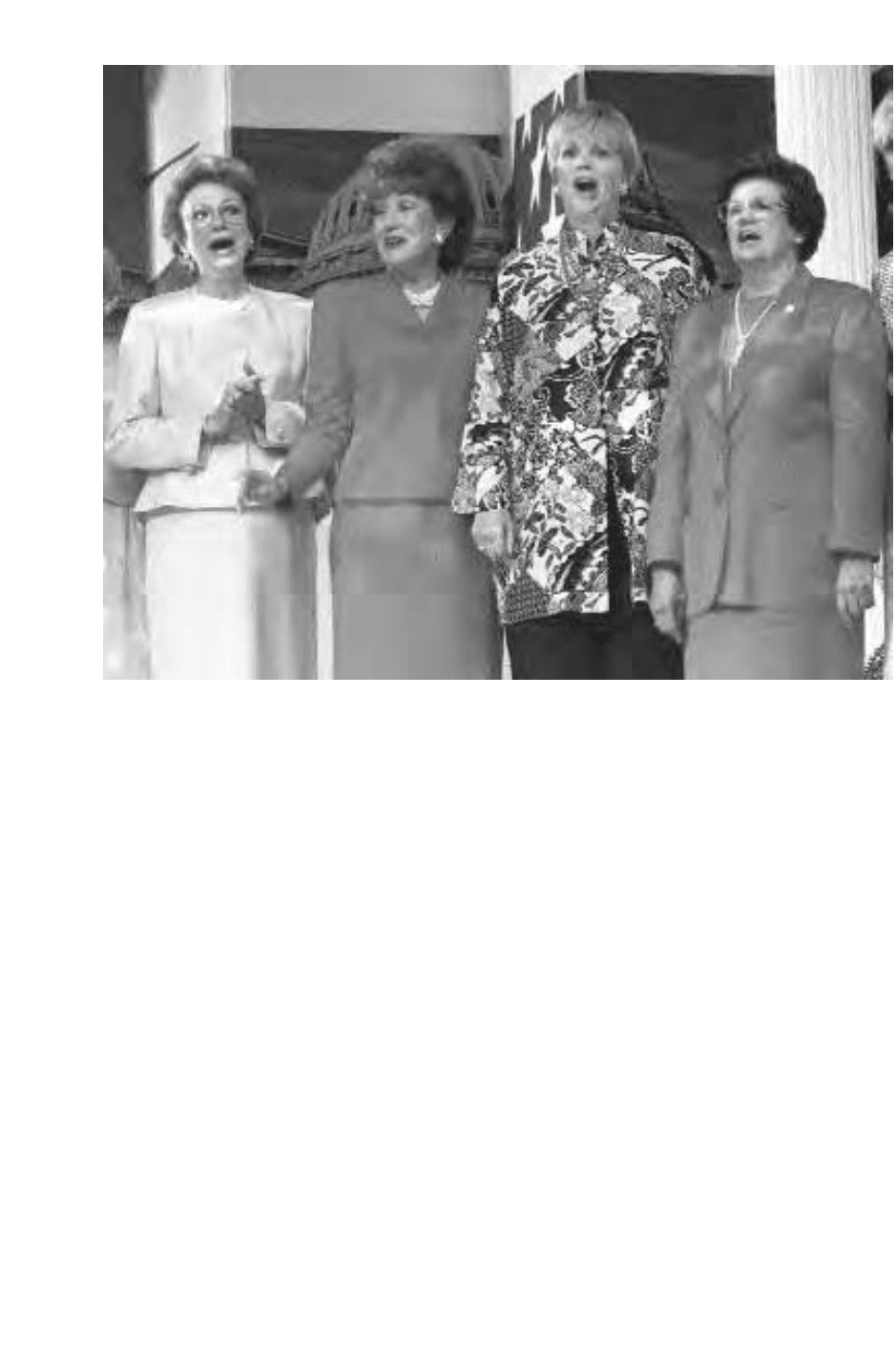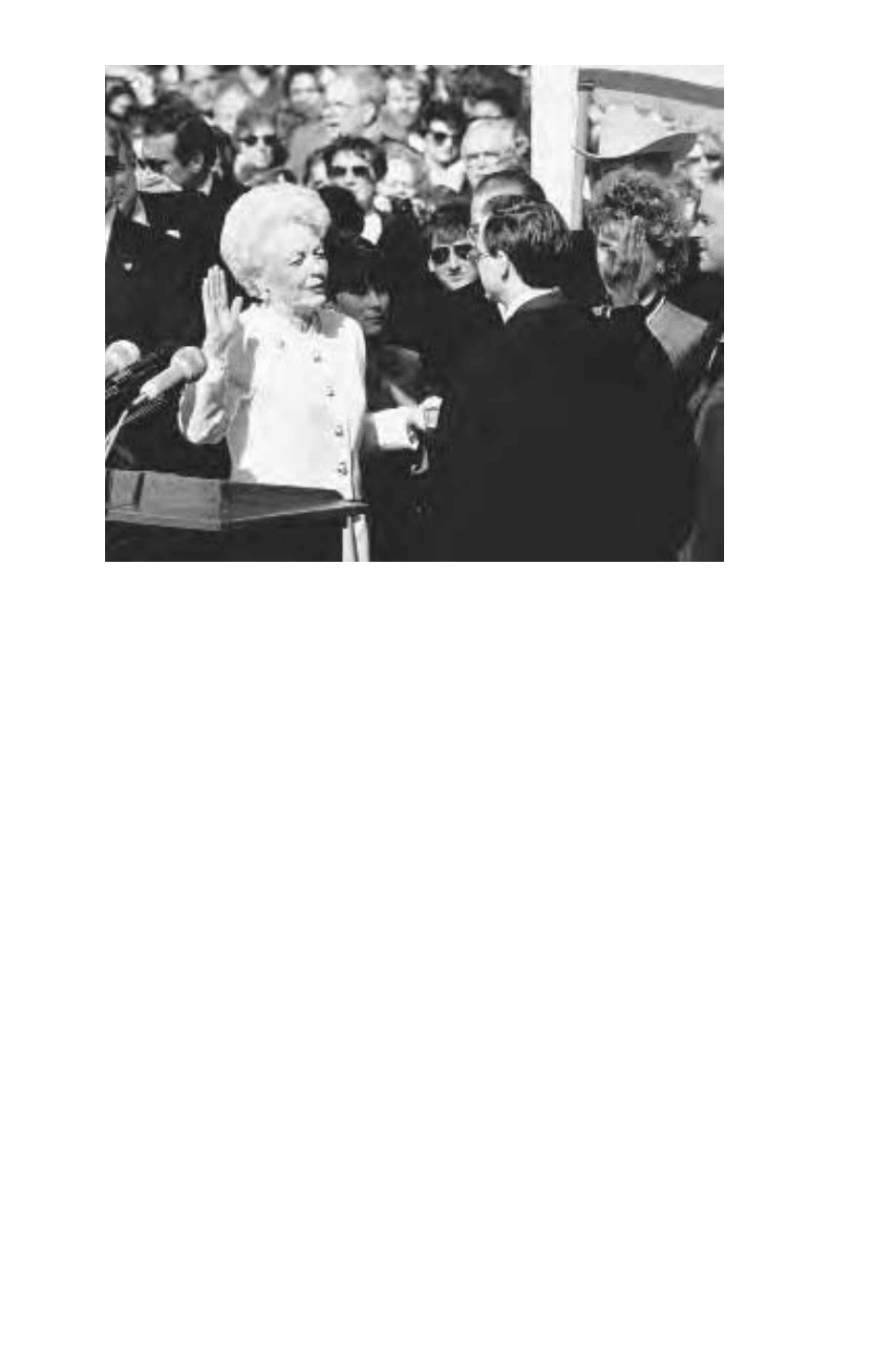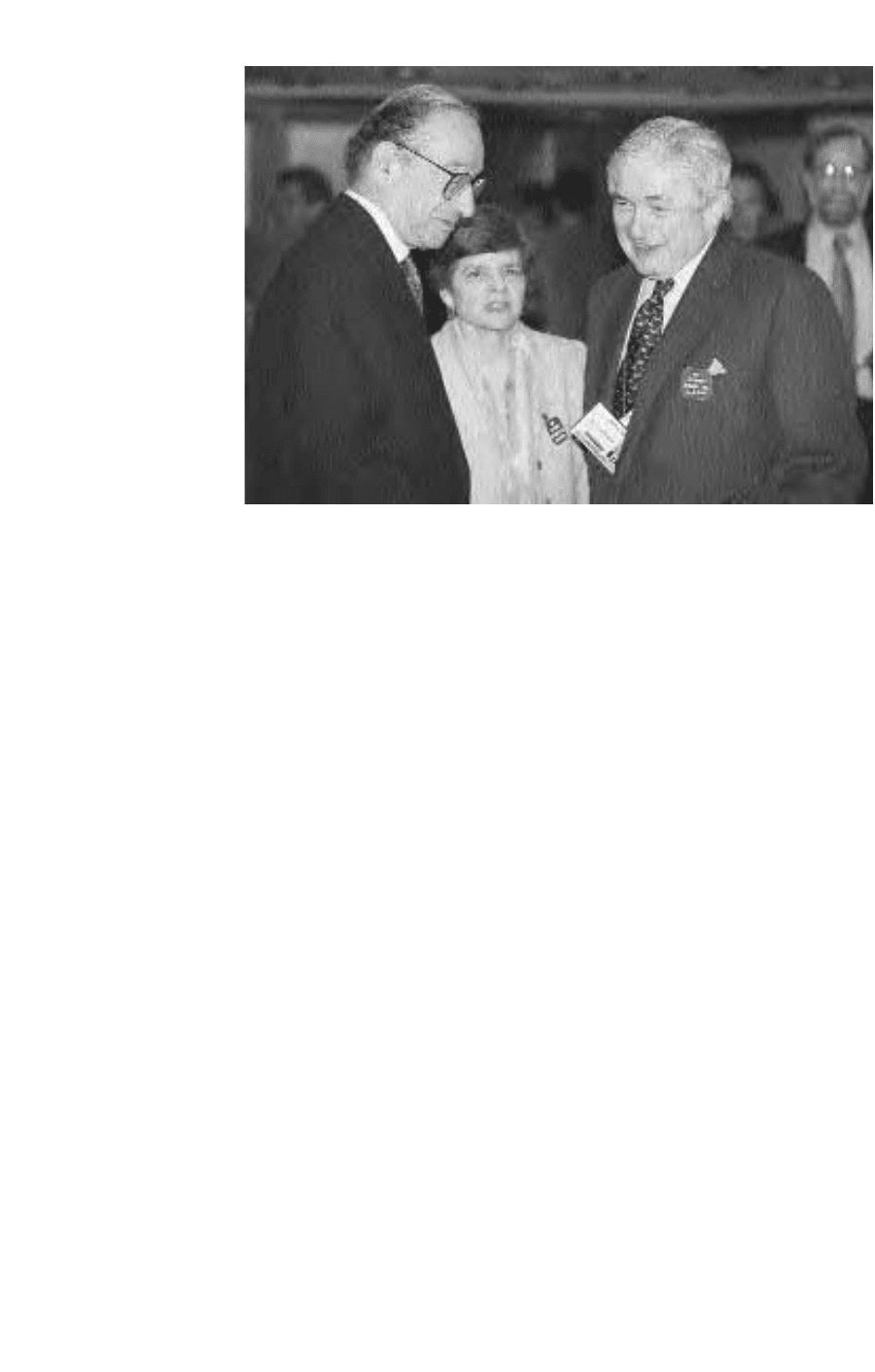Schenken Suzanne O’Dea. From Suffrage to the Senate: An Encyclopedia of American Women in Politics (2 Volumes)
Подождите немного. Документ загружается.


attorney for Dade County. She was elected to the office of state attorney
in November 1978, where she served until 1993.
As state attorney, Reno was responsible for an annual budget of $30
million and 940 employees. Her office prosecuted cases involving homi-
cide, child abuse, rape, drug trafficking, and white-collar crimes. She
helped reform the juvenile justice system and pursued parents who were
delinquent on their child support payments. She also established a special
court for drug offenses. During her tenure, she dealt with race riots, waves
of immigrants, political corruption, and police brutality.
Reno’s priorities as U.S. attorney general include reducing crime and
violence by incarcerating serious, repeat offenders and finding alternative
forms of punishment for first-time offenders. By focusing on prevention
and early intervention, she hopes to keep children away from gangs,
drugs, and violence. Other priorities include protecting the environment
and making integrity, excellence, and professionalism the hallmarks of the
Department of Justice.
Shortly after becoming attorney general and head of the U.S. De-
partment of Justice, Reno was faced with several crises: she was responsi-
ble for the investigation of the terrorist bombing of the New York World
Trade Center; allegations were made that the director of the Federal Bu-
reau of Investigation (FBI) had been involved in misconduct; and the Bu-
reau of Alcohol, Tobacco, and Firearms was engaged in a standoff with the
Branch Davidians, a religious group in Waco, Texas. After two months,
Reno authorized the FBI to use nonlethal tear gas to end the siege, but a
fire erupted that killed eighty-five people. Reno took full responsibility for
the tragedy. A Department of Justice inquiry challenged some of the state-
ments she had made regarding the reasons for using the tear gas and crit-
icized her for not being more directly involved in the siege.
Reno has traveled across the country, speaking to bar associations, el-
ementary school students, and rehabilitation clinics and visiting police
stations to inspect crime-fighting programs.
See also Cabinets, Women in Presidential
References Congressional Quarterly, Cabinets and Counselors: The President and
the Executive Branch (1997); New York Times, 12 February 1993, 15 May 1994;
www.usdoj.gov/bios/jreno.html.
Reproductive Rights
Reproductive rights are based upon the premise that human dignity and
equality grant each person the right and the responsibility to make repro-
ductive decisions for herself or himself. Information about human sexu-
ality and reproduction is fundamental to making those decisions, as is ac-
cess to the services necessary to act upon the decisions. Among the areas
Reproductive Rights 569

encompassed by reproductive rights are good personal health practices,
fertility, family planning, pregnancy, fetal development, childbirth, con-
traception, and abortion. Reproductive rights include fertility services for
infertile couples, prenatal care that enhances the health of mother and fe-
tus, delivery and postnatal procedures that contribute to the health of
mother and baby, safe abortion procedures, freedom from forced sterili-
zation, and many other reproductive options.
In the United States, a range of obstacles inhibit women’s exercise of
their reproductive rights. Financial barriers prevent many poor and low-
income women, especially women of color, from having adequate health
insurance. Even women who have health insurance may find that their in-
surance company discriminates against them by refusing to cover birth
control prescriptions while covering prescriptions for male erectile dys-
function like Viagra. Medicaid, the government health insurance program
for poor people, does not cover most abortions, further limiting low-in-
come women’s options. Economic considerations are also a barrier to
women having regular gynecological exams and mammograms. Inade-
quate or nonexistent prenatal care contributes to infant mortality rates be-
ing nearly twice as high for Native American and African American infants
as they are for white infants. Another economic factor that limits the full
exercise of reproductive rights appears in welfare programs. For example,
some states cap benefits to families that have additional children while re-
ceiving welfare, a policy known as a “family cap.” Forced sterilizations,
forced use of contraceptives, and unneeded surgical procedures during
childbirth (Cesarean section deliveries) are violations of reproductive
health rights that are imposed upon women of color and low-income
women more frequently than upon wealthier white women. The uneven
distribution of health care providers across the country also limits repro-
ductive rights. Twenty-six percent of the counties in the United States do
not have a hospital or clinic that provides prenatal care, and more than
half of the counties do not have an abortion provider. Inner-city health fa-
cilities may be understaffed and often have inadequate funding.
See also Abortion
References www.crlp.org.
Republican Party, Women in the
Women’s relationship with the Republican Party has ranged from trying
to find their place in it to strong party allegiance to their growing dissat-
isfaction with it in the 1990s, as evidenced by the gender gap. For many
women, the National Federation of Republican Women, an auxiliary, has
provided an avenue for them to develop their skills and make their con-
570 Republican Party, Women in the

tributions. Other women have worked to created places for themselves
and other women in the party itself.
At the 1876 Republican National Convention, a Massachusetts
woman became the first woman to address a convention committee when
she made a presentation to the Resolutions Committee on woman suf-
frage. Women were first officially seated at the 1892 convention, when two
women from Wyoming were alternate delegates. Also at that convention,
for the first time a woman addressed an entire convention, saying that
women were there to help the party and were there to stay. The first
woman delegate to a Republican National Convention was also a
Wyoming woman, who was seated in 1900.
The Republican Party reluctantly endorsed woman suffrage at its
1916 national convention, but it endorsed state amendments only, not the
federal amendment that suffrage leaders sought. As states granted women
suffrage rights, the party sought to gain their support and their votes by
establishing the Women’s Division of the Republican National Committee
(RNC) in 1919. After women gained suffrage rights nationwide in 1920,
the party created the position of associate member, one for each state, to
give women a voice but not a vote in the party’s decisionmaking body.
Republican Party, Women in the 571
Republican women
gathered for a tribute
from the Republican
National Committee
(left to right):
Republican National
Committee cochair
Evelyn McPhail,
Elizabeth Dole,
Maureen Reagan,
and Representative
Barbara Vucanovich
(R-NV), 1996 (Asso-
ciated Press AP)

Delegates to the 1924 Republican National Convention discarded the clas-
sification of associate members and created the office of national com-
mitteewoman, parallel to the existing national committeeman, again one
for each state.
The years between 1932 and 1952 were difficult for the party. De-
mocrats held the presidency, and they gained significant attention for the
number of women appointed to posts in the party and in government. In
addition, Democratic women had the tremendous benefit of Eleanor
Roosevelt’s advocacy for their inclusion in party leadership. Republican
women, however, had formed local women’s clubs for decades, and al-
though many of them existed only through an election cycle and then dis-
banded, some of them had become semipermanent by the 1930s. To im-
pose discipline on them, develop members’ skills, and organize their
efforts, RNC assistant chairperson Marion Martin brought the clubs to-
gether under an umbrella organization, the National Federation of Re-
publican Women, in 1937. The clubs proved to be a significant resource
during elections, but for most women, the clubs did not advance their sta-
tus or power in the party machinery.
In 1940, the Republican National Convention endorsed the Equal
Rights Amendment, the first major party to include the amendment in its
platform. That year, women gained equal representation on all RNC com-
mittees. Equal representation on the convention committees took signifi-
cantly longer, but the process started in 1944 when women gained equal
representation on the resolutions committee.
The 1952 presidential campaign was the party’s first organized effort
to mobilize American women’s vote, a strategy developed Ivy Baker Priest
for Dwight D. Eisenhower. The 1952 campaign was also the first time that
the gender gap appeared, with a greater proportion of female than male
voters supporting Republican Eisenhower. The next gender gap would not
appear until the 1980s. President Eisenhower appointed Oveta Culp Hobby
secretary of the Department of Health, Education, and Welfare in 1953, the
first Republican woman to serve in a Republican president’s cabinet.
Women’s status and power in the party, however, changed little be-
tween 1924 and the late 1960s. Margaret Chase Smith ran for the party’s
presidential nomination in 1964, and the next year Elly Peterson of Michi-
gan was the first woman to chair a state party in either major party, but
most women continued to be excluded from positions of power and sta-
tus in the Republican Party. Partly to increase the number of women del-
egates to the 1972 national convention, a group of women convinced the
party to establish the Delegates and Organization Committee (DOC) to
review the party’s rules and make recommendations. Chaired by Rose-
mary Ginn of Missouri, the DOC could only make suggestions to states
572 Republican Party, Women in the

about selecting delegates to the 1972 Republican National Convention,
but the committee called on each state to “endeavor to have equal repre-
sentation of men and women in its delegation.” Seventeen percent of the
1968 convention delegates had been women, but by 1972 almost 30 per-
cent of the delegates were women.
One of the groups that had worked with Ginn and her committee
was the newly formed National Women’s Political Caucus (NWPC), an
organization that sought to increase women’s power in the political par-
ties and to encourage and help women gain election or appointment to
public offices. The NWPC established an office at the 1972 Republican
National Convention to organize delegates to support the Equal Rights
Amendment and reproductive rights. NWPC executive director Doris
Meissner invited women delegates to daily meetings to explain the cau-
cus’s purpose, goals, and strategies. The convention strengthened the
party’s statement supporting the ERA, passed two rules calling on state
parties to increase their efforts to broaden the diversity of their delega-
tions to the 1976 convention, and ignored reproductive rights.
In 1974, at the recommendation of President Gerald Ford, the RNC
elected Mary Louise Smith as chair. The first woman to hold the position
in the Republican Party, Smith became chair during one of the party’s
most difficult times, only a few weeks after President Richard Nixon re-
signed in the midst of the Watergate scandal. Throughout the more than
two years Smith chaired the party, her primary focus centered on rebuild-
ing the party, which at times could claim the allegiance of as few as 17 per-
cent of Americans.
The Republican Women’s Task Force (RWTF) of the National
Women’s Political Caucus led the campaign to keep the Equal Rights
Amendment in the party’s 1976 platform. President Ford and RNC chair-
person Mary Louise Smith both strongly supported the amendment, and
Smith was a strong advocate for abortion rights. By 1976, however, Re-
publican leader Phyllis Schlafly had organized Stop ERA, and Ronald Rea-
gan was challenging Ford for the party’s nomination. Ford’s intercession
kept the amendment in the platform. Instead of feminists adding a repro-
ductive rights plank to the platform, the party added an antiabortion
plank to the platform, despite valiant efforts by Representative Millicent
Fenwick of New Jersey to keep it out.
At the 1980 convention, former RNC chairperson Smith repre-
sented feminists at the platform hearings, and she met with likely presi-
dential nominee Ronald Reagan to discuss abortion rights and the ERA.
The convention expressed strong prolife sentiments and removed the
ERA from the platform. Moderate Republicans, both women and men,
found themselves increasingly distanced from the party, whereas conser-
Republican Party, Women in the 573

vative Republicans on the religious right were nurturing their con-
stituencies into dominance in the party. Party cochair, moderate Mary
Dent Crisp, was pushed out of the party in 1980 because of her prochoice
views. The fissures that had appeared between feminists and the party in
1976 became chasms by 1984. In addition, women, regardless of their
views on abortion and the ERA, increasingly receded into the back-
ground, with the exception of Schlafly, who did not have an office in the
party but did have power.
The party’s conservative views served it well in many ways. After
Ronald Reagan’s 1980 election to the presidency and his reelection in
1984, his vice president, George Bush, succeeded him in 1988. The gender
gap that had first appeared in the 1980 race between Jimmy Carter and
Reagan expanded throughout the 1980s: women voters increasingly fa-
vored the Democratic Party and its candidates more than men did, and
men increasingly favored the Republican Party and its candidates. In the
1992 presidential contest between President Bush and Democratic nomi-
nee Bill Clinton, women provided Clinton with the winning margin of
votes, as they did again in 1996. Republican women have tried to convince
the party to address the gender gap by developing programs that will at-
tract women voters. At the end of the twentieth century, however, the Re-
publican Party continued to lose women voters’ support.
See also Abortion; Adkins, Bertha Sheppard; Democratic Party, Women in the;
Equal Rights Amendment; Fenwick, Millicent Hammond; National Federation
of Republican Women; National Women’s Political Caucus; Schlafly, Phyllis
Stewart; Smith, Margaret Madeline Chase; Smith, Mary Louise; Stop ERA
References Feit, “Organizing for Political Power: The National Women’s Political
Caucus” (1979); Freeman, “Feminism vs. Family Values: Women at the 1992
Democratic and Republican Conventions” (1995), “Who You Know vs. Who
You Represent: Feminist Influence in the Democratic and Republican Parties”
(1987); “NFRW: Fifty Years of Leadership, 1938–1988” (1987).
Republicans for Choice
Founded in 1989 by Republican activist Ann E. W. Stone, Republicans for
Choice (RFC) seeks to build a prochoice movement within the Republi-
can Party, remove the party’s antichoice platform plank, and elect pro-
choice Republicans. RFC contends that historically the Republican Party
has been prochoice, and that in the 1990s, more than 70 percent of the
party membership is prochoice. RFC opposes a constitutional amend-
ment prohibiting abortions, arguing that opposing governmental inter-
ference in private lives is a tenet of the Republican Party.
See also Abortion; Republican Party, Women in the
References www.rfc-pac.org.
574 Republicans for Choice

Richards, Ann Willis (b. 1933)
Democrat Ann W. Richards was governor of Texas from 1991 to 1995 and
was treasurer of Texas from 1983 to 1991. She gave a keynote address to
the 1988 Democratic National Convention, during which she said that
Vice President George Bush was “born with a silver foot in his mouth.”
The speech and its humor gained her national celebrity.
Richards became active in politics in the 1950s, working on local and
statewide campaigns and for civil rights and economic justice issues. She
worked in John F. Kennedy’s 1960 presidential campaign, and in 1962 she
helped form the groups North Dallas Democratic Women and the Dallas
Committee for Peaceful Integration. Richards responded to Sarah Wed-
dington’s pleas for help in her 1972 campaign for a seat in the Texas House
of Representatives and later managed Weddington’s legislative office for a
session. She also helped other women win legislative races.
In 1976, Richards ran for and won a seat on the Travis County Com-
missioners Court, where she helped create the state’s first juvenile proba-
tion system. She explained that at the time,“Texas was not noticeably hos-
pitable to the notion that a woman could handle that kind of
responsibility.” She served until 1982.
In 1983, Richards became treasurer of Texas and was reelected to a
second four-year term in 1986. As treasurer, Richards modernized the of-
fice’s procedures and initiated innovations in banking and investment that
earned unprecedented returns for the state. She helped formulate plans to
Richards, Ann Willis 575
Governor Ann
Richards (D-TX)
was sworn in as the
governor of Texas,
1991 (Courtesy:
Texas State Library
and Archives
Commission)

provide water and sewers to impoverished areas of the state and guided
the state through a fiscal crisis. Richards, who had gone through an alco-
holism treatment program in 1980, obtained health insurance coverage
for substance abuse treatment for state employees.
In 1989, Richards published her autobiography, Straight from the
Heart: My Life in Politics and Other Places. She also entered Texas’s race for
governor that year. During her campaign for governor, Richards pledged
that there would be no new taxes, called for a “new Texas,” and asked vot-
ers to help her “take back the government.”
Elected governor of Texas in 1990, Richards stressed education, pub-
lic safety, economic development, and efficiency during her administra-
tion. As governor, Richards increased the amount of prison space, reduced
the number of violent offenders released from prison, and introduced a
new substance abuse program in the prisons. She also attracted new and
expanded manufacturing facilities to the state. After losing her bid for re-
election in 1994, she joined a law firm as a senior adviser.
Born in Lakeview, Texas, Richards earned her bachelor of arts degree
from Baylor University in 1954 and attended the University of Texas at
Austin, where she earned her teaching certificate. Richards taught social
studies and history from 1955 to 1956.
See also Governors, Women
References Mullaney, Biographical Directory of the Governors of the United States
1988–1994 (1994); New York Times, 18 July 1988; Richards, Straight from the
Heart: My Life in Politics and Other Places (1989).
Riley, Corrine Boyd (1893–1979)
Democrat Corrine Riley of South Carolina served in the U.S. House of
Representatives from 10 April 1962 to 3 January 1963. After her husband,
Congressman John Jacob Riley, died in office, she won the special election
to fill the vacancy. Congresswoman Riley introduced a bill to have the
General Services Administration transfer surplus property to the South
Carolina State Historical Society and another to require television to be
equipped with both ultra high– and very high–frequency channels. She
was not a candidate for another term.
Born in Piedmont, South Carolina, Corinne Riley graduated from
Converse College in 1915. She taught high school from 1915 to 1937. A
field representative for the South Carolina State Text Book Commission
from 1938 to 1942, she worked for the Civilian Personnel Office at Shaw
Air Force Base from 1942 to 1944.
See also Congress, Women in
References Office of the Historian, U.S. House of Representatives, Women in
Congress, 1917–1990 (1991).
576 Riley, Corrine Boyd

Rivers, Lynn Nancy (b. 1956)
Democrat Lynn Rivers of Michigan entered the U.S. House of Represen-
tatives on 3 January 1995. Rivers entered politics, she said, “as a mom who
got mad at the system.” She served on the Ann Arbor school board from
1984 to 1992 and in the Michigan House of Representatives from 1993 to
1995. Rivers brought her experiences as a teen mother, the wife of an auto
worker, an adult student, and a school board member to her work as a
congresswoman. She has said, “I understand what families are struggling
with. I know what it’s like to go without health insurance, not to be able
to buy a home, and to have more bills than money.”
Rivers sees education as the key to improving the economy, advo-
cates investing in vocational and school-to-work programs, and favors de-
veloping private-public ventures to create high-wage, high-skill jobs for
workers. She sponsored legislation banning gifts to members of Congress
and another measure to end congressional benefits such as pensions and
automatic pay raises.
Born in Au Grey, Michigan, Rivers attended the Bay-Arenac Skills
Center and trained in commercial food preparation. She earned her bach-
elor of arts degree from the University of Michigan in 1987 and her law
degree from Wayne State University in 1992.
See also Congress, Women in; State Legislatures, Women in
References Congressional Quarterly, Politics in America 1996 (1995); www.
house.gov/rivers/bio.htm.
Rivlin, Alice Mitchell (b. 1931)
The first head of the Congressional Budget Office, Alice Rivlin became
deputy director of the Office of Management and Budget in 1993 and di-
rector of it in 1994 and served as vice chair of the Board of Governors of
the Federal Reserve Board from 1996 to 1999. An economist, Rivlin began
her public service career as consultant to the House Committee on Edu-
cation and Labor from 1961 to 1962 and to the secretary of the treasury
from 1964 to 1966, when she became deputy assistant secretary for the
Department of Health, Education, and Welfare. Two years later, President
Lyndon Johnson appointed her assistant secretary for planning and eval-
uation in the department.
In 1974, Congress created the Congressional Budget Office (CBO),
part of landmark federal budget reform legislation. The CBO, a nonparti-
san agency, assists Congress in analyzing and forming policy on the fed-
eral budget. During her tenure, Rivlin insisted that the CBO had “taken no
policy position, nor will we ever.” Appointed jointly by the speaker of the
House of Representatives and the president pro tempore of the Senate,
Rivlin, Alice Mitchell 577

Rivlin took office in 1975 and served two four-year terms. She left the
CBO in 1983 when she became director of economic studies at the Brook-
ings Institution. In 1993 Rivlin joined President Bill Clinton’s administra-
tion as deputy budget director. Known for her strong support for reduc-
ing the federal deficit, Rivlin held an important role in developing the
annual federal budget.
Born in Philadelphia, Pennsylvania, Rivlin graduated from Bryn
Mawr in 1952 and earned her master of arts degree in 1955 and her doc-
toral degree in 1958, both from Radcliffe College. Rivlin became a re-
search fellow at the Brookings Institution in 1957 and by 1969 was a se-
nior fellow. During those years, she wrote and coauthored several studies
in economics and related areas.
References H. W. Wilson, Current Biography Yearbook, 1982 (1982); New York
Times, 28 June 1994; www.bog.frb.fed.us.
Roberts, Barbara Hughey (b. 1936)
Democrat Barbara Roberts was governor of Oregon from 1991 to 1995.
The first woman governor of the state, Roberts reorganized elementary
and secondary schools and provided state employees with unpaid family
leave. She also worked to diversify the state’s economy to reduce its re-
liance on the logging industry.
Roberts began her political career as an unpaid lobbyist seeking help
for her autistic son. In the late 1960s, she succeeded in getting the Oregon
legislature to pass the nation’s first education rights law for emotionally
handicapped children. Her legislation also created the State Advisory
Committee for Emotionally Handicapped Children. Roberts applied for
578 Roberts, Barbara Hughey
Federal Reserve vice
chair Alice Rivlin
talked with Federal
Reserve Board chair
Alan Greenspan
and World Bank
president James
Wolfensohn before
the International
Monetary Fund
Interim Committee
meetings in
Washington, D.C.,
1999 (Corbis/AFP)
